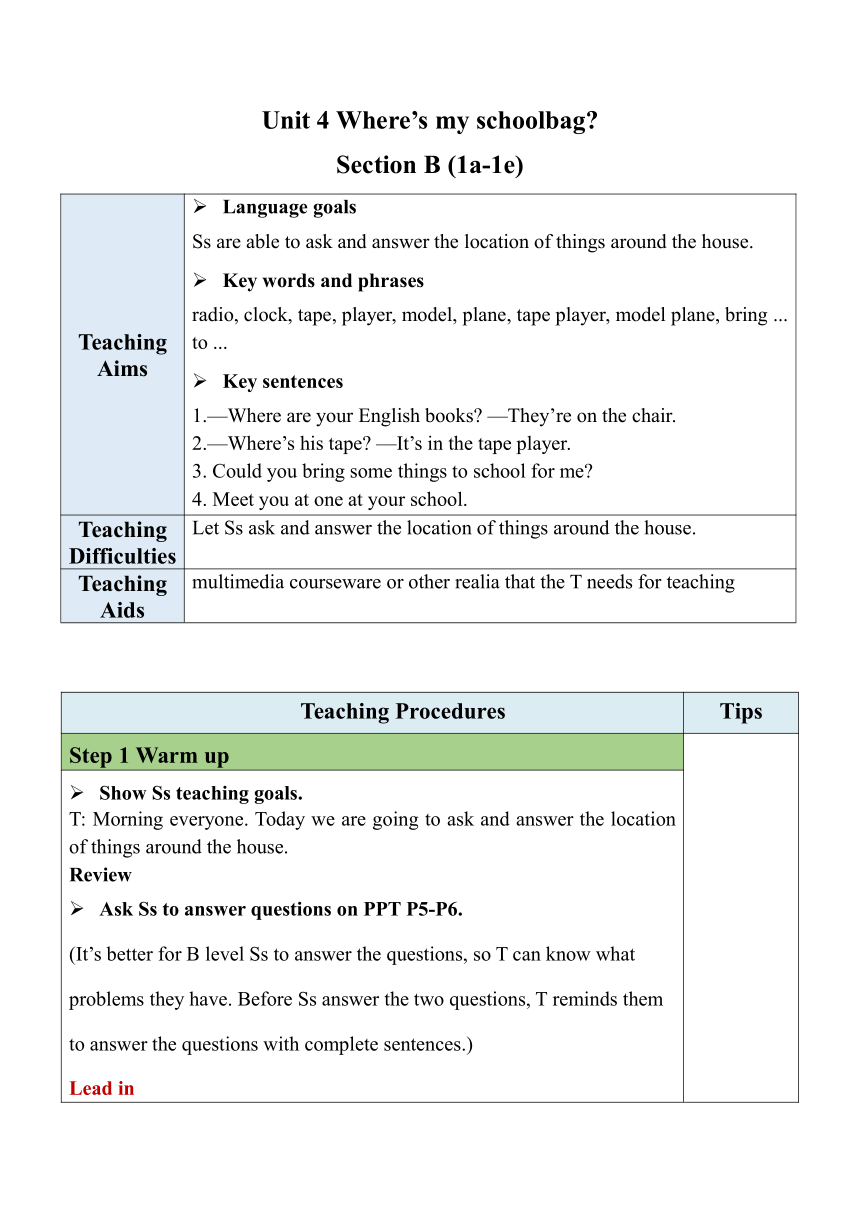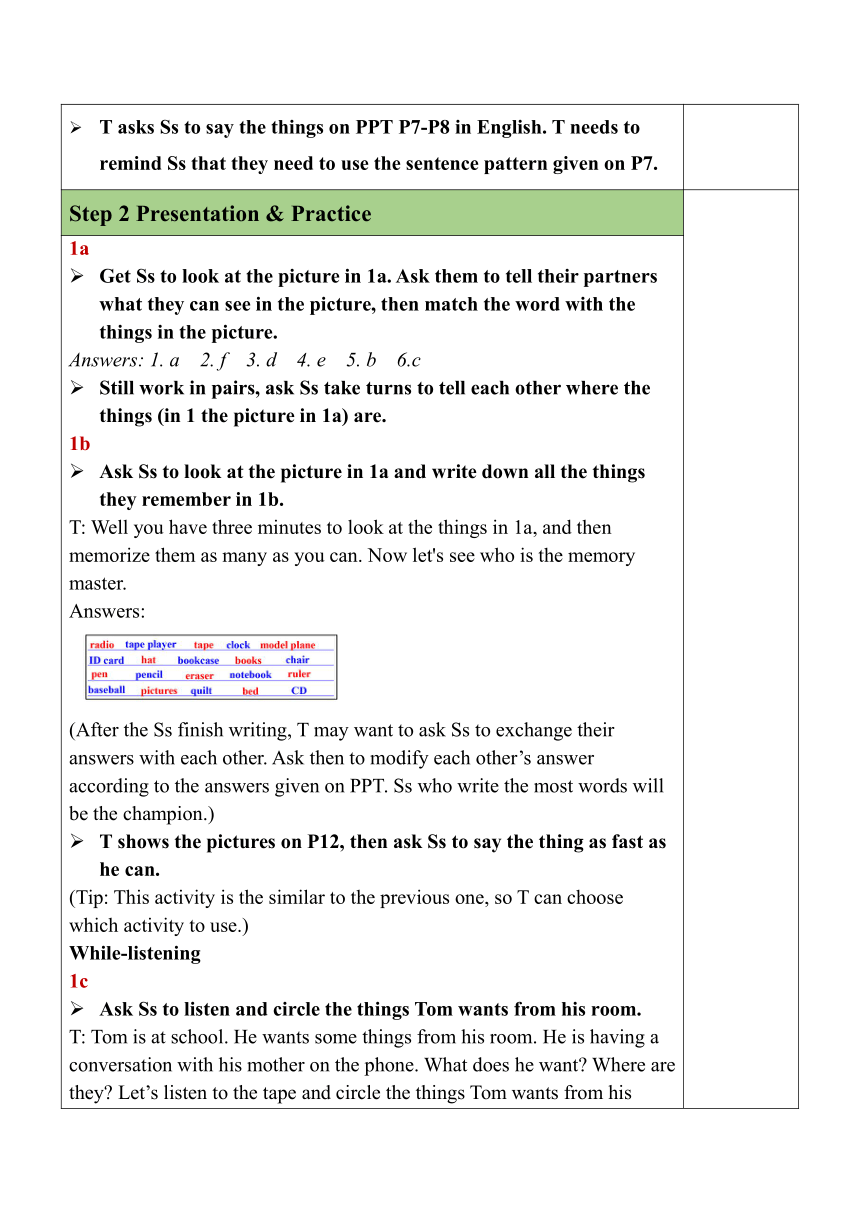Unit 4 Where’s my schoolbag?Section B (1a-1e) 表格式教案
文档属性
| 名称 | Unit 4 Where’s my schoolbag?Section B (1a-1e) 表格式教案 |

|
|
| 格式 | docx | ||
| 文件大小 | 46.9KB | ||
| 资源类型 | 教案 | ||
| 版本资源 | 人教新目标(Go for it)版 | ||
| 科目 | 英语 | ||
| 更新时间 | 2023-10-23 10:36:10 | ||
图片预览


文档简介
Unit 4 Where’s my schoolbag
Section B (1a-1e)
Teaching Aims Language goals Ss are able to ask and answer the location of things around the house. Key words and phrases radio, clock, tape, player, model, plane, tape player, model plane, bring ... to ... Key sentences 1.—Where are your English books —They’re on the chair. 2.—Where’s his tape —It’s in the tape player. 3. Could you bring some things to school for me 4. Meet you at one at your school.
Teaching Difficulties Let Ss ask and answer the location of things around the house.
Teaching Aids multimedia courseware or other realia that the T needs for teaching
Teaching Procedures Tips
Step 1 Warm up
Show Ss teaching goals. T: Morning everyone. Today we are going to ask and answer the location of things around the house. Review Ask Ss to answer questions on PPT P5-P6. (It’s better for B level Ss to answer the questions, so T can know what problems they have. Before Ss answer the two questions, T reminds them to answer the questions with complete sentences.) Lead in T asks Ss to say the things on PPT P7-P8 in English. T needs to remind Ss that they need to use the sentence pattern given on P7.
Step 2 Presentation & Practice
1a Get Ss to look at the picture in 1a. Ask them to tell their partners what they can see in the picture, then match the word with the things in the picture. Answers: 1. a 2. f 3. d 4. e 5. b 6.c Still work in pairs, ask Ss take turns to tell each other where the things (in 1 the picture in 1a) are. 1b Ask Ss to look at the picture in 1a and write down all the things they remember in 1b. T: Well you have three minutes to look at the things in 1a, and then memorize them as many as you can. Now let's see who is the memory master. Answers: (After the Ss finish writing, T may want to ask Ss to exchange their answers with each other. Ask then to modify each other’s answer according to the answers given on PPT. Ss who write the most words will be the champion.) T shows the pictures on P12, then ask Ss to say the thing as fast as he can. (Tip: This activity is the similar to the previous one, so T can choose which activity to use.) While-listening 1c Ask Ss to listen and circle the things Tom wants from his room. T: Tom is at school. He wants some things from his room. He is having a conversation with his mother on the phone. What does he want Where are they Let’s listen to the tape and circle the things Tom wants from his room. Answers: circled : English books, ruler, notebook, tape 1d Ask Ss to listen again and write down where Tom’s things are. Answers: The English books are under the video. The ruler is on the bed. Th notebook is under the model plane in the bookcase. The tape is in the tape player. T may want Ss to complete the conversation on P16 and P17, then check their answers by listening the recording again. (After Ss listen to the conversation and finish the task, T can ask them to read the listening scripts. T highlights the key sentence patterns: 1. Could you bring some things to school for me 2. Meet you at one at your school. T can also ask Ss to underline the collocation: bring… to …, and translate the key sentences for Ss if necessary. T tell Ss the spelling of two fallible words: radio, tape. ) Post-listening 1e Ask Ss to ask and answer questions about the things in Tom’s room in pairs. (One S is A and one S is B. Make conversations about the things in Tom’s room in 1d. Then switch the roles. T gives samples on P19.)
Step 3 Language points learning
radio n. 收音机;无线电广播。 radio station 无线电台 listen to the radio 听广播 on the radio 在广播中 radio program广播节目
Step 4 Exercises & Homework
Exercises Ask Ss to do the exercises on PPT P21-P23. T ask Ss to make a summary about language points they learned today. Homework Preview the passage in Section B 2b. Do the exercises in students’ book.
Teaching Reflection The game memory master makes the class interesting and vivid. The effect of writing the words on paper is better than oral expression. T can dictate the key sentences to help students to memorize better at the end of the class.
Section B (1a-1e)
Teaching Aims Language goals Ss are able to ask and answer the location of things around the house. Key words and phrases radio, clock, tape, player, model, plane, tape player, model plane, bring ... to ... Key sentences 1.—Where are your English books —They’re on the chair. 2.—Where’s his tape —It’s in the tape player. 3. Could you bring some things to school for me 4. Meet you at one at your school.
Teaching Difficulties Let Ss ask and answer the location of things around the house.
Teaching Aids multimedia courseware or other realia that the T needs for teaching
Teaching Procedures Tips
Step 1 Warm up
Show Ss teaching goals. T: Morning everyone. Today we are going to ask and answer the location of things around the house. Review Ask Ss to answer questions on PPT P5-P6. (It’s better for B level Ss to answer the questions, so T can know what problems they have. Before Ss answer the two questions, T reminds them to answer the questions with complete sentences.) Lead in T asks Ss to say the things on PPT P7-P8 in English. T needs to remind Ss that they need to use the sentence pattern given on P7.
Step 2 Presentation & Practice
1a Get Ss to look at the picture in 1a. Ask them to tell their partners what they can see in the picture, then match the word with the things in the picture. Answers: 1. a 2. f 3. d 4. e 5. b 6.c Still work in pairs, ask Ss take turns to tell each other where the things (in 1 the picture in 1a) are. 1b Ask Ss to look at the picture in 1a and write down all the things they remember in 1b. T: Well you have three minutes to look at the things in 1a, and then memorize them as many as you can. Now let's see who is the memory master. Answers: (After the Ss finish writing, T may want to ask Ss to exchange their answers with each other. Ask then to modify each other’s answer according to the answers given on PPT. Ss who write the most words will be the champion.) T shows the pictures on P12, then ask Ss to say the thing as fast as he can. (Tip: This activity is the similar to the previous one, so T can choose which activity to use.) While-listening 1c Ask Ss to listen and circle the things Tom wants from his room. T: Tom is at school. He wants some things from his room. He is having a conversation with his mother on the phone. What does he want Where are they Let’s listen to the tape and circle the things Tom wants from his room. Answers: circled : English books, ruler, notebook, tape 1d Ask Ss to listen again and write down where Tom’s things are. Answers: The English books are under the video. The ruler is on the bed. Th notebook is under the model plane in the bookcase. The tape is in the tape player. T may want Ss to complete the conversation on P16 and P17, then check their answers by listening the recording again. (After Ss listen to the conversation and finish the task, T can ask them to read the listening scripts. T highlights the key sentence patterns: 1. Could you bring some things to school for me 2. Meet you at one at your school. T can also ask Ss to underline the collocation: bring… to …, and translate the key sentences for Ss if necessary. T tell Ss the spelling of two fallible words: radio, tape. ) Post-listening 1e Ask Ss to ask and answer questions about the things in Tom’s room in pairs. (One S is A and one S is B. Make conversations about the things in Tom’s room in 1d. Then switch the roles. T gives samples on P19.)
Step 3 Language points learning
radio n. 收音机;无线电广播。 radio station 无线电台 listen to the radio 听广播 on the radio 在广播中 radio program广播节目
Step 4 Exercises & Homework
Exercises Ask Ss to do the exercises on PPT P21-P23. T ask Ss to make a summary about language points they learned today. Homework Preview the passage in Section B 2b. Do the exercises in students’ book.
Teaching Reflection The game memory master makes the class interesting and vivid. The effect of writing the words on paper is better than oral expression. T can dictate the key sentences to help students to memorize better at the end of the class.
同课章节目录
- starters 预备篇(2012秋审查)
- Unit 1 Good morning !
- Unit 2 What’s this in English?
- Unit 3 What color is it ?
- Unit 1 My name's Gina.
- Section A
- Section B
- Unit 2 This is my sister.
- Section A
- Section B
- Unit 3 Is this your pencil?
- Section A
- Section B
- Unit 4 Where's my schoolbag?
- Section A
- Section B
- Unit 5 Do you have a soccer ball?
- Section A
- Section B
- Unit 6 Do you like bananas?
- Section A
- Section B
- Unit 7 How much are these socks?
- Section A
- Section B
- Unit 8 When is your birthday?
- Section A
- Section B
- Unit 9 My favorite subject is science.
- Section A
- Section B
